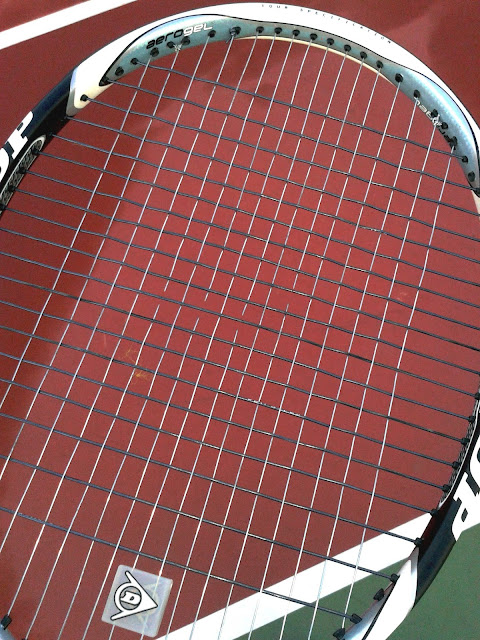Monday, 2 September 2013
Fancy: Galvanized Steel Wire?
Before you start thinking this is outrageous and report this to some "Society of Prevention of Cruelty to Tennis Rackets", know that steel wire strings HAVE BEEN USED quite widely in the past. (link1)(link2)(link3)
I have not gone bonkers! What enticed me were online reports of some friends' friend's racket that they claim generated tremendous spin when they tried it. And yes, they attributed it to the steel strings.
I tested several different types of steel wires and found that some aspects of steel wire were actually very close to kevlar!
Both kevlar and steel wire:
- have very little stretch during initial tension,
- suffer huge tension loss at tie-offs, and
- "tightens back" when the crosses were installed.
My last grommets fiasco (link) has taught me to be more careful. Moreover, any blocked holes by this steel wire would probably be completely unpassable. So proper planning is crucial.
I "converted" the original 18x20 Dunlop Aerogel 200 to a 16x19 in order to:
1. eliminate blocked holes,
2. protect the grommets by tying off differently, and
3. allow more "give" in the stringbed since steel has almost zero stretch.
Before any of the more adventurous ones try stringing this, please read this first.
Before stringing, a weigh-in was done.
Steel wire is extremely kinky after being packed in coils for so long. Threading was very slow to prevent cuts to the hands and grommets. Lots of other precautions were also taken.
A closer look below.
Below pic shows how I used the grommet from the first cross string to tie-off the mains onto the mains.
I had chosen a thin wire to prevent adding too much weight after stringing. Even 23grams feel quite significant when swinging the racket around.
Playtest:
- This is playable!
- It was not uncomfortable or harsh at all. Ball impacts felt very similar to a poly/syn gut hybrid.
- Surprisingly, there is still some soft pocketing even though the stringbed felt very tight and stable. It was very easy to aim with this stick.
- Coming from my preferred ELT setups, the rebound angle of this is very low. No problem though, all I had to do is just aim higher and bash the ball fearlessly.
- Power levels are very similar to a poly/syn gut hybrid. The feel is definitely not dead. Even volleying is not difficult!
- When swinging, there is the added joy of hearing the "swishing" sound of the metal strings. After a while, I was able to distinguish how the "swish" sounds like for good shots. Bad shots either did not have the "swish" sound, or it "swished" too early before impact. Too steep a swingpath from low-to-high (to generate more spin) also produced a very different "swish" tone. I think this is a very interesting instructional cum feedback tool!
- Spin is really good. I don't understand how it could be so, but it just works. Topspin, slices and spin serves were all great and accurate!
- Sadly, to keep the weight down, I had chosen too thin a gauge. This steel wire is only 0.7mm thick. A flat serve I attempted snapped four mains simultaneously...
- This pic was taken immediately after the strings snapped. Interestingly, if you observe the gap between the four snapped strings, the spacing is similar. Does this indicate that this steel wire has some stretch and can hold tension? Maybe a thicker gauge next time?
Subscribe to:
Post Comments (Atom)









This answers one question I´ve made myself all my life. Once I strunged with fishing nylon, I think it was the equivalent of a 18-19 gauge. It was horrible, no spin, no power, no control and lasted for 15 min.
ReplyDeleteThanks.
Yes, I recalled the power level was extremely low for these steel strings. It felt like a very stiff and low-powered poly string. Except that the bite and spin was very impressive.
Delete